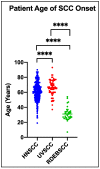Impaired Wound Healing, Fibrosis, and Cancer: The Paradigm of Recessive Dystrophic Epidermolysis Bullosa
- PMID: 34065916
- PMCID: PMC8151646
- DOI: 10.3390/ijms22105104
Impaired Wound Healing, Fibrosis, and Cancer: The Paradigm of Recessive Dystrophic Epidermolysis Bullosa
Abstract
Recessive Dystrophic Epidermolysis Bullosa (RDEB) is a devastating skin blistering disease caused by mutations in the gene encoding type VII collagen (C7), leading to epidermal fragility, trauma-induced blistering, and long term, hard-to-heal wounds. Fibrosis develops rapidly in RDEB skin and contributes to both chronic wounds, which emerge after cycles of repetitive wound and scar formation, and squamous cell carcinoma-the single biggest cause of death in this patient group. The molecular pathways disrupted in a broad spectrum of fibrotic disease are also disrupted in RDEB, and squamous cell carcinomas arising in RDEB are thus far molecularly indistinct from other sub-types of aggressive squamous cell carcinoma (SCC). Collectively these data demonstrate RDEB is a model for understanding the molecular basis of both fibrosis and rapidly developing aggressive cancer. A number of studies have shown that RDEB pathogenesis is driven by a radical change in extracellular matrix (ECM) composition and increased transforming growth factor-beta (TGFβ) signaling that is a direct result of C7 loss-of-function in dermal fibroblasts. However, the exact mechanism of how C7 loss results in extensive fibrosis is unclear, particularly how TGFβ signaling is activated and then sustained through complex networks of cell-cell interaction not limited to the traditional fibrotic protagonist, the dermal fibroblast. Continued study of this rare disease will likely yield paradigms relevant to more common pathologies.
Keywords: fibrosis; recessive dystrophic epidermolysis bullosa; squamous cell carcinoma; therapies; wound healing.
Conflict of interest statement
The authors declare no conflict of interest.
Figures


References
-
- Rosenbloom J., Macarak E., Piera-Velazquez S., Jimenez S.A. Human Fibrotic Diseases: Current Challenges in Fibrosis Research. Methods Mol. Biol. 2017;1627:1–23. - PubMed
Publication types
MeSH terms
Substances
Grants and funding
LinkOut - more resources
Full Text Sources
Other Literature Sources
Medical
Research Materials
Miscellaneous

